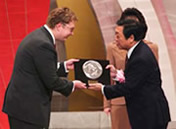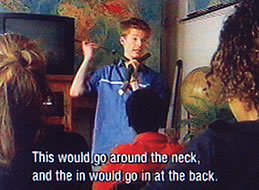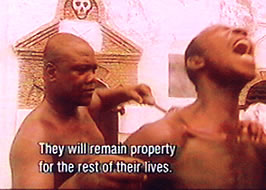|
 |
|
 |
 |
 |
 |
Content |
|
 |
   |
 |
 This
historical drama opens with a high school student preparing for the upcoming
presentation on slavery. His desk is piled high with books about slavery.
He gives an introduction to his presentation by showing a videotape. This
historical drama opens with a high school student preparing for the upcoming
presentation on slavery. His desk is piled high with books about slavery.
He gives an introduction to his presentation by showing a videotape.
 This first episode in the
series is about villagers working peacefully on the West African coast.
They are caught and packed into a ship like sardines in a can and transported
across the Atlantic. This first episode in the
series is about villagers working peacefully on the West African coast.
They are caught and packed into a ship like sardines in a can and transported
across the Atlantic. |
| |
 |
 |
Jury Comments |
|
 |
 This
program is a brave attempt to address an issue that is critical to our understanding
of cultural roots--slavery--and to relate it to contemporary society from
the point of view of young people. To understand society today we have to
know our history and how it continues to impact on our relationships with
other races and cultures. By the clever use of drama, both contemporary
and historical reconstruction, the program encourages empathy and understanding. This
program is a brave attempt to address an issue that is critical to our understanding
of cultural roots--slavery--and to relate it to contemporary society from
the point of view of young people. To understand society today we have to
know our history and how it continues to impact on our relationships with
other races and cultures. By the clever use of drama, both contemporary
and historical reconstruction, the program encourages empathy and understanding. |
| |
 |
 |
Producer's comments |
|
|
 |
Mr. Willem A. van der Spek, Projectmanager School
TV and Scriptwriter "Slavery",
TELEAC/NOT Educational Broadcasting Corporation |
 |
 It
is a 3-part drama-series about the history of slavery. Bought on the western
coast of Africa by European merchants they were transported by European
ships to the other side of the Atlantic and set to work in the America’s.
This happened for more than two centuries till the abolition of slavery
in the 19th century. It is a story not well known in the Netherlands. Yet
5% of the African-slave-trade was Dutch business. It is not only their history
but of the Dutch as well. It
is a 3-part drama-series about the history of slavery. Bought on the western
coast of Africa by European merchants they were transported by European
ships to the other side of the Atlantic and set to work in the America’s.
This happened for more than two centuries till the abolition of slavery
in the 19th century. It is a story not well known in the Netherlands. Yet
5% of the African-slave-trade was Dutch business. It is not only their history
but of the Dutch as well.
 The importance of the series
lays in breaking the silence of that history which is a black page in the
history-books. In promoting opening the history study-books about slavery
in the schools our SchoolTV-series “Slavery” has a special objective.
Every pupil, and their teachers as well, will be touched by the images of
the slaves in Africa, their awful transport with so many Africans on small
ships and their life on the plantations. Than they will ask questions: how
could this happen, how did Europeans think in those days of slavery and
blacks, do we think different in our time? The importance of the series
lays in breaking the silence of that history which is a black page in the
history-books. In promoting opening the history study-books about slavery
in the schools our SchoolTV-series “Slavery” has a special objective.
Every pupil, and their teachers as well, will be touched by the images of
the slaves in Africa, their awful transport with so many Africans on small
ships and their life on the plantations. Than they will ask questions: how
could this happen, how did Europeans think in those days of slavery and
blacks, do we think different in our time?
 The Dutch government accepted
this version and granted a Slavery-monument that is unveiled by Queen Beatrice
in an Amsterdam Park in July 2002. Recently a museum/documentary centre
of Slavery-studies has started in Amsterdam. The Dutch government accepted
this version and granted a Slavery-monument that is unveiled by Queen Beatrice
in an Amsterdam Park in July 2002. Recently a museum/documentary centre
of Slavery-studies has started in Amsterdam.
 Getting the Japan-prize
for “Slavery” is therefore more than a prize for a tv-program,
we feel it as well as a support for breaking the silence. Getting the Japan-prize
for “Slavery” is therefore more than a prize for a tv-program,
we feel it as well as a support for breaking the silence. |
 |

